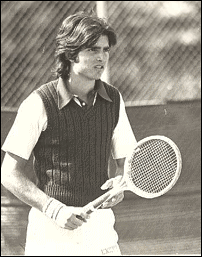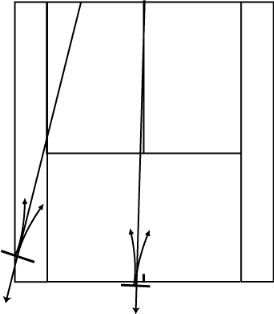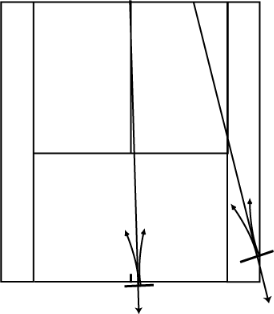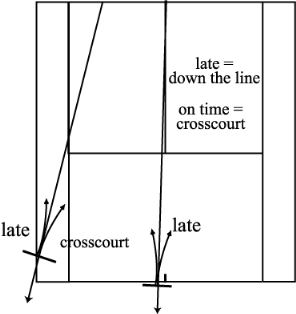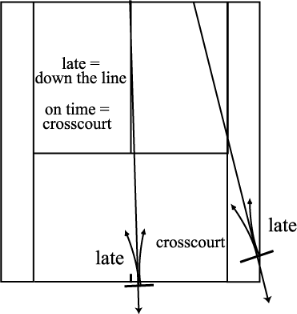Revolutionary Tennis |
||
Tennis Instruction That Makes Sense |
||
Step 11 Serve Return & Approach Shot Señoras y señores, bienvenidos a la corrida de toros. ¡Toro, toro! Ladies and gentlemen, welcome to the bullfight, a.k.a. the return of serve. The bull charges, the matador stands his ground and plays it close. Similarly, your opponent charges with his serve and you, the returner, must in the end stand your ground and play it close. ¡OLÉ! The serve/return dance is very much like a bull fight. The server (bull) has the advantage, but the returner (matador) can blunt the advance through skill. And, at the root of it all lies this question: ¿QUIEN ES MAS MACHO? Jimmy Connors and Andre Agassi are the two most macho returners of all time. All the great Aussies were tough, too, Laver, Newcombe, Hoad, and Gonzales, Segura, and I'm sure Vines and Tilden were tough, but the idea of being mas macho, of actually taking that return and doing something with it instead of merely blunting the attack, is clearly exemplified by Connors and Agassi. This is the psychology of the serve return, it's you against him/her. Who's going to win, quien es mas macho? Here comes the serve... ¡Olé! Most everything written on the serve return is accurate. You're supposed to watch the ball as your opponent tosses it, move into the ball, look at it bounce, shorten your back/forward swing, put the ball back in play, chip or slice it, choose ahead of time where to place it, do what you can to get it back, don't play it too large, etc. All is valid. Revolutionary Tennis will now add something distinctive to the serve return: vision and movement direction, that is how to watch the ball and in what direction to move to make sure you're moving into the ball. If you follow Revolutionary Tennis you're familiar with the fact that the ball angles away from you, that to move "into the ball" your movement direction is on a certain angle relative to the ball's angle, and that your movement pattern is based on having 2 feet. On the serve return it is all too common not to move into the ball but away with it. Inefficient footwork and movement direction compromises your vision (you're turning too much) and you miss time the ball, and it also compromises your body because it leaves your body in a position that can not support your contact "out in front." The result is crap.
MOVE INTO THE BALL No matter how well you play, for my money your return of serve improves when you know how to move forward into the ball.. This is all about diagramming that understanding. Moving forward means moving inside, or forward from, that 90 degree line you make to the ball's flight line. The following two diagrams illustrate where that lies. To make sure you're moving into the ball you move: - roughly to the net post, or down the alley, when the ball is on the alley side of the box. - roughly parallel to the baseline and towards the baseline when the ball is on the T.
These angles are different from a groundstroke so you have to get used to them, especially where on one side you move parallel to the baseline (serve in the T) and not into the body of the court per se like you "think" you ought to, and on the other side you're moving sharply into the court on an angle (serve wide).
An old high school photo here shows my attitude when returning serve. It helps me to remember this when I return serve today since that sneer isn't there automatically anymore. And look at that grip! photo by V. Campbell
VISION Vision requirements are the same but your perspective of and on the court is different for a serve return. Don't turn head too much on wide shots, don't turn head too little on T-shots or you'll naturally miss time it. See Step 7. If you hit the ball long odds are you're turning your head too much to the one side and telling your brain you're planning to hit it later than it should be hit. Conversely, if it goes into the net or sharply crosscourt you're hitting too early and you're probably not tracking the ball laterally enough. RACKET CONTACT Perspective problems here too. You're used to the racket being more or less parallel to the net during regular groundstrokes executed more from the center of the court. But on serve returns your perspective and reality are both different. Remember to look at this from a bird's eye view. It doesn't matter if you hit topspin or slice, I'm talking about the racket's point of view on the court. When the serve is wide toward the alley, the racket, generally, angles into the court more than you're used to on most groundstrokes. When the serve is in the "T" the angle is more parallel to the horizontal lines and net than you're used to (unless you think on groundstrokes your racket is supposed to be parallel to the net at contact, if so see Step 6).
PLACEMENT Placement is simplified into hit left/right, deep/short, wide/center. Divide opponent's court into 2 halves, left and right side, that is his forehand and backhand. Divide that into 2 more halves deep and short, using the service line as demarcation. Divide that into 2 more halves, wide, and center. Determine ahead of time where you want to return the serve, at least to one side or the other. Of course if the serve doesn't cooperate and you have to change your mind you change your mind. Just don't wait until the last possible moment before deciding where to hit it. Get that part out of the way as soon as possible. The beginning of Anticipation (a good subject for another individual section). When you're on time you generally go crosscourt easier, and when you're a little later on the ball it goes down the line better. These are directions from the racket's point of view, remember, per Step 7. Late is down the line, on time is crosscourt.
A lot has been written on how to play against certain types of players. Regardless of who you play against and the strategy you use against him or her you'll need to move efficiently, move in the proper direction to go into the ball, move your feet in a particular pattern for rhythm and balance, and see the ball in a particular way for more success.
APPROACH SHOT It used to be the approach shot was all about running up to the ball, stopping, turning sideways, being flat footed or standing "balanced," stroking, then re-starting yourself and going up to the net. In other words, run, stop, run again. Thankfully that bit of business is over with. Today, for the most part, players are told to move (not run) through the ball as best as possible, that is you should not stop before you hit because this is a fluid stroke, like a running forehand or backhand. You can slow down, yes, but not literally come to a stop. I wrote those two paragraphs and decided to search "approach shots" on the internet. I found: "Hit the ball from a motionless, balanced position. At impact, both feet should be firmly on the ground in a balanced position with your body weight equally distributed." "Turn sideways completely when preparing to hit your approach shot." Gag me. The Flat Earth Society exists, too. Look 'em up. Your body weight will not be equally distributed, it can not be since you're moving so much through the ball; both feet will not be firmly on the ground for the same reason, though one of them will be; and sideways, or turning sideways, does not belong in tennis' vocabulary for any stroke.
DIFFICULTY - SOLUTION The difficulty on the approach shot, if you just look at the stroke itself, lies in the fact you are moving through the ball when hitting it. You're moving through 'cause you're on your way to the net. With so much movement your balance, vision, and timing are easily thrown off. It's a cousin of the running groundstroke, yet you don't get a full runner's gait, a full swing, and a full court to play into that a running groundstroke enjoys, all of which help mitigate problems associated with movement. To prevent problems associated with movement keep your torso back, don't lean forward. You're going to lean forward when you first begin to run forward, yes, for 2 steps, but then catch yourself, bring your torso back, and let your legs take you to the ball. You are not running a race where your chest has to lean across a finish line. Most of the advice on how to stroke an approach shot you already know. That is you generally hit the ball up the line, the stroke is shorter than a full groundstroke, you don't go for too much, you strike the ball at the apex of the bounce when possible. Revolutionary tennis does not have much to offer in this area except to that the open stance forehand approach shot, often taught today as running up to the ball, stopping and loading on the back foot, must be a conspiracy to make the approach shot, and the ensuing volley, extinct.
FOOTWORK - BALANCE Your gait is important when running up to the ball, it leads directly to your balance and posture when striking the ball. You should strive to take regular style steps, where one foot passes the other, for as many steps as possible. Obviously when you're closer to the ball you'll need to take small steps, that is small steps or stutter steps, and not side-steps. Pros stutter step and the ensuing effect is sneaker noise, but sadly the teaching establishment understands this as taking side-steps. You will slow down as you get closer to the ball. Your gait will adjust and the steps may stutter, but at least for the first 2-3 steps you should try to move as normally as possible. It's not important for you to speed up to the ball, it's important that the rising stakes don't detract from your personal control. Too often everyone just plain ole rushes everything and the result is crap. Be poker faced. Think here for a second. You're running, taking regular length steps, and suddenly you take smaller length steps. What happens to your torso? It leans forward. Prevent it from happening, don't act like a cartoon character who can't stop leaning over and falls off the cliff. The big misdirection in established technique for the approach shot is arguing which foot is down last prior to contact. Back foot for open stance, or front foot for closed stance? It doesn't matter which foot is down last prior to hitting the ball because you take the timing as it comes. In this manner you focus on what's important for an approach shot: getting up to the ball appropriately, not rushing or overdoing, remaining in control. Perhaps this helps to explain the success of both styles, front/back foot, on approach shots. Of course you can argue hitting off the back/front foot is better for up the line/crosscourt, but you should figure this out by yourself. The only time when hitting off the back foot is really needed is on a running groundstroke. In fact, celebrity teachers are trying to "teach" players to keep their center of gravity ahead of the front foot on contact in order to get to the net faster. That idea, though valid, is related to movement and balance. Improve on those two areas per Revolutionary Tennis' ideas and the center-of-gravity thing becomes moot.
SIDESTEPPING - WEAKNESSES - SOLUTIONS At times you may need to sidestep into the ball, that is you do a series of 2/4/6 sidesteps sideways while moving forward. Not recommended but often it happens because it happens. That's okay, as long as you realize what you're doing and understand its weakness. It happens when the ball's slow and you're all over it like a fly on garbage. The weakness of sidestepping into the ball is threefold. You don't cover ground as best as possible (though it may not be necessary), it throws your balance off way more (you're leaning to the side), and your vision will be further compromised by leaning to the side. You can sidestep into the ball as long as you don't try to cover ground with this stepping pattern. Sidestepping into the ball is for taking up time, as in the ball's slow coming your way and if you moved into it like you really could you'd overwhelm it. Keep your torso back when sidestepping for balance and vision (not easy to do when you're imbalanced this way). If you maintain your posture and vision requirements, and if you avoid rushing or overwhelming the ball, your timing can be okay even with the, ahem, aforementioned faux pas. A popular footwork misconception promoted by the USTA and others involves the backhand approach shot. Here the misconception is the back foot slides in behind the front foot. Moving the back foot behind the front foot brings you back away from the ball, the ball is angling away from you. It is needed only when you overrun the ball. It's simple geometry. By taking the back foot and moving it inward, or away from the ball angling away from you, you are then moving away, or inward, from it. Use this pattern to slow yourself down or if you've overrun the ball. However use a regular footwork pattern and a backhand approach shot if you want to get to the ball sooner and have more power available when hitting it.
VISION Keeping the torso back enables you to time the ball better. When you lean forward your eyes are telling your brain you're ready to hit the ball farther out ahead of you than is required. You'll feel awkward and the shot will be poorly played because you miss-timed the ball.
WHACK THE BALL One area that's not addressed is whacking the ball. Yes, you need to take a smaller swing, and yes, the stroke is designed to position the ball, but you still have to take a swipe at it. You need a full swing, not a full swing like a groundstroke swing, but a full "approach shot" swing, which means you swing but you don't drive the ball as far. There is no traditional follow-through on an approach shot, it varies widely. Of course there is a "follow through" on the swing itself, but no set marker where to end up. At times you will punch-stroke the ball, other times you will bring the racket up, other times over one shoulder or the other. Hitting the ball with more spin comes to mind here, but you can succeed brilliantly if you approach the ball, calm down, see the ball well, "hold" the stroke, and then strike the ball relatively flat. This works well, but I know it's difficult to do when the adrenalin's flowing and you're closer to your opponent and you want to drive it right by him/her. Regardless of how hard you hit the ball, you still need the gumption to do what needs to be done. Too many people chicken out with their approach shot and play safe. Whether you hit the ball hard or deftly place the ball, you gotta have courage, man. Too many players walk the plank when hitting an approach shot. Short approach shots work well, and hitting the ball through the singles sideline is often overlooked in favor of hitting the ball "deep" or into the corner. Luckily you can practice this shot on your own. Stand behind the baseline and pitch the tennis ball up in the air and forward into the court. The idea is you're going to run up to the ball and hit it hard over the net and in the court. Start by letting the ball bounce twice before hitting it, then let it bounce once when you get the hang of it. You'll soon notice how your footwork and balance get thrown off simply by running forward, you'll notice how you'll miss-time the ball (vision) for the same reason. Follow some of the suggestions above regarding footwork, balance, and keeping the torso back and your result should improve.
|
||||||||
|
|
||||||||||||||||||||||||||||||||||||||||||||||||||||||||||||||
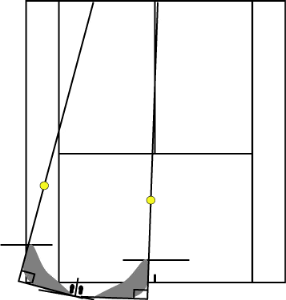
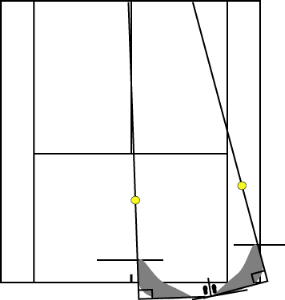 The grey area roughly indicates moving forward into the ball, and the horizontal lines at their ends shows how on one side you're always moving farther in the court than on the other. If the ball is slow you would angle forward into it a little bit more, and if the ball's not as wide you have to force yourself to move and forward, just like you have to at the net (because the ball's not wide away from you - see how it all integrates?). When the serve's in the T and you angle in forward too much, into the diagram's white area, you're moving inward too much and not to the ball.
The grey area roughly indicates moving forward into the ball, and the horizontal lines at their ends shows how on one side you're always moving farther in the court than on the other. If the ball is slow you would angle forward into it a little bit more, and if the ball's not as wide you have to force yourself to move and forward, just like you have to at the net (because the ball's not wide away from you - see how it all integrates?). When the serve's in the T and you angle in forward too much, into the diagram's white area, you're moving inward too much and not to the ball.